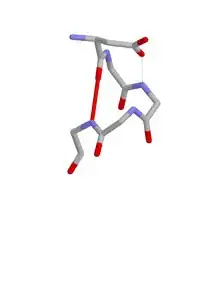The Asx motif is a commonly occurring feature in proteins and polypeptides.[1][2] It consists of four or five amino acid residues with either aspartate or asparagine as the first residue (residue i). It is defined by two internal hydrogen bonds. One is between the side chain oxygen of residue i and the main chain NH of residue i+2 or i+3; the other is between the main chain oxygen of residue i and the main chain NH of residue i+3 or i+4. Asx motifs occur commonly in proteins and polypeptides.

When one of the hydrogen bonds is between the main chain oxygen of residue i and the side chain NH of residue i+3 the motif incorporates a beta turn. When one of the hydrogen bonds is between the side chain oxygen of residue i and the main chain NH of residue i+2 the motif incorporates an Asx turn.
As with Asx turns, a significant proportion of Asx motifs occur at the N-terminus of an alpha helix with the Asx as the N cap residue. Asx motifs have thus often been described as helix capping features.[3][4][5][6]
A related motif is the ST motif which has serine or threonine as the first residue.
References
- ↑ Wan, WY; Milner-White EJ (1999). "A natural grouping of motifs with an aspartate or asparagine forming two hydrogen bonds to amino acids ahead in sequence". Journal of Molecular Biology. 286 (5): 1633–1649. doi:10.1006/jmbi.1999.2552. PMID 10064720.
- ↑ Lee, J; Dubey VK (2008). "A logical OR redundancy within the asx-pro-asx-gly type I beta turn motif". Journal of Molecular Biology. 377 (4): 1251–1264. doi:10.1016/j.jmb.2008.01.055. PMID 18308335.
- ↑ Presta, LG; Rose GD (1988). "Helix Caps". Science. 240 (4859): 1632–1641. doi:10.1126/science.2837824. PMID 2837824.
- ↑ Doig, AJ; MacArthur MW (1997). "Structures of N-termini of helices in proteins". Protein Science. 6 (1): 147–155. doi:10.1002/pro.5560060117. PMC 2143508. PMID 9007987.
- ↑ Aurora, R; Rose GD (1998). "Helix Capping". Protein Science. 7 (1): 21–38. doi:10.1002/pro.5560070103. PMC 2143812. PMID 9514257.
- ↑ Gunasekaran, K; Nagarajam HA (1998). "Stereochemical punctuation marks in protein structure" (PDF). Journal of Molecular Biology. 275 (5): 917–932. doi:10.1006/jmbi.1997.1505. PMID 9480777.
External links
- ↑ Leader, DP; Milner-White EJ (2009). "Motivated Proteins: A web application for studying small common three-dimensional protein motifs". BMC Bioinformatics. 10 (1): 60. doi:10.1186/1471-2105-10-60. PMC 2651126. PMID 19210785.
- ↑ Golovin, A; Henrick K (2008). "MSDmotif: exploring protein sites and motifs". BMC Bioinformatics. 9 (1): 312. doi:10.1186/1471-2105-9-312. PMC 2491636. PMID 18637174.